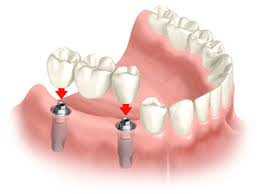Dental bridges are appliances that “bridge” the gap created by one or more missing teeth. They are made up of one or more crowns for the teeth adjacent to the gap, along with a false tooth or teeth attached. These anchoring teeth are called abutment teeth and the false teeth are called pontics. The latter can be made from gold, alloys, porcelain, zirconia or a combination of these materials. The result is a dentition that is fully restored in terms of function and appearance.
Four main types of dental bridge are available as a means of tooth replacement.

- Conventional bridges are used when there are natural teeth present on both sides of the gap created by the missing tooth. They involve reshaping the teeth on either side of the gap to make room for cementing crowns on them, with a pontic in between to replace the missing tooth.
- Cantilever bridges are used when there is an adjacent teeth on only one side of the missing tooth or teeth. The pontic is supported on only one side, rather than on both sides, by one or two crowned abutments (depending on how much support is required/the length of the bridge). Since this type of bridge is supported on only one side, it may act as a lever leading to complications such as fractured teeth or loosened crowns. The risk is high at the back of the mouth due to strong molar biting forces that can weaken the bridge.
- Maryland bridges (resin-bonded bridges) are considered a conservative alternative to traditional bridges. These bridges consist of a single pontic that is held in place by a metal or porcelain framework (wing). This framework is bonded onto the back of the tooth adjacent to the missing tooth with composite resin cement. Minimal alteration of the adjacent tooth is required – your dentist will need to remove only a very small amount of tooth from the back surfaces of these teeth to make room for the wing. The strength of the bridge is limited by the strength of the resin that holds it in place, so it may dislodge if used in the molar areas.
- Implant-supported bridges are the most stable means of tooth replacement. The dentist surgically embeds tiny biocompatible implants made of titanium in a patient’s jawbone, and these secure the entire restoration. One dental implant is placed for every missing tooth. An alternative is a pontic suspended between two implant-supported crowns. Patients who are considering an implant-supported bridge must have enough healthy bone in their jaws to support the implants. X-rays, CT scans and other tests may be required to investigate the quality and quantity of the bone. The procedure is expensive, invasive and time consuming, with a long recovery time and post-treatment sensitivity. However, the outcome of this treatment option can last a lifetime, making it worth the investment.

To help you choose your ideal bridge option, your dentist will plan your treatment depending on the number and location of missing teeth, presence and health of the adjacent teeth as well as quantity and quality of your jaw bone (in implant cases). In complex cases, your general dentist may refer you to see a specialist prosthodontist, periodontist or oral and maxillofacial surgeon.
What are the differences between materials used for dental bridges
Gold, Silver, and Metal Alloys
- Strongest and most durable type of restoration
- Minimal drilling of the patient’s natural tooth structure
- Poor aesthetic quality
- Recommended at the back of the mouth in the molar area (able to withstand strong biting forces and no interference with aesthetics)
Porcelain-Fused-to-Metal (PFM)
- Metal base for strength and stability
- Overlying porcelain to match the patient’s natural tooth colour
- Natural tooth structure sacrificed to accommodate for both the metal and porcelain layers
- Better aesthetics than metal bridges
All Ceramic
- Not as strong as metal
- As they are thicker, they require more alteration of the supporting teeth
- Superior aesthetics – blend seamlessly with a patient’s natural teeth
Zirconia
- Type of dental ceramic
- Virtually as strong as metal
- Typically requires very little alteration of the natural tooth structure
- Comes in a wide range of shades, and a dentist can select a colour that is a near-perfect match for the patient
- Slightly translucent – can reflect light, much like dental enamel
When choosing one material over another, consideration will be given to your budget, lifestyle, overall oral health and personal preference.

